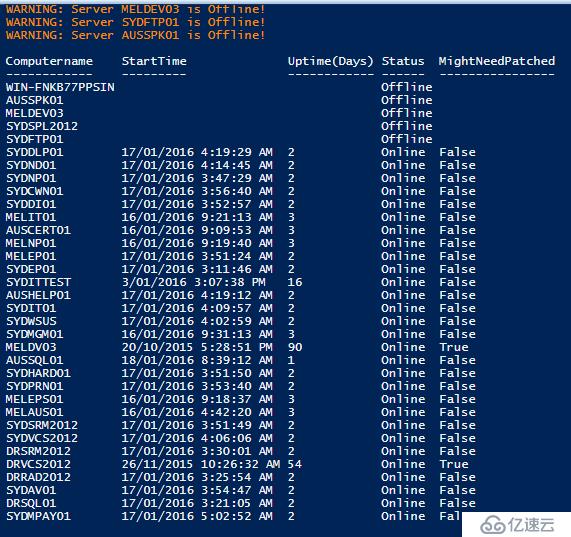您好,登錄后才能下訂單哦!
您好,登錄后才能下訂單哦!
每個月Powershell.Org上面都會有一期小挑戰,一般都是要求實現一些實踐性很強的小腳本。
這一期的鏈接如下
http://powershell.org/wp/2016/01/02/january-2016-scripting-games-puzzle/
基本要求是:
Server uptime is the lifeblood of system administrators. We strive on it, get addicted to it..we need…more server uptime! Don’t you think something as addictive and important as server uptime be measured? How do we know we’re getting our uptime fix? As that famous quote goes, “Reality does not exist until it’s measured.”. Let’s measure it not only for our own sake but also to give a pretty report to our manager with all those whizbang, doohickey Excel juju that they love to see!
For this month’s challenge, I want you to create a PowerShell function that you can remotely point to a Windows server to see how long it has been up for. Here’s an example of what it should output.

Requirements:
1. Support pipeline input so that you can pipe computer names directly to it.
2. Process multiple computer names at once time and output each computer’s stats with each one being a single object.
3. It should not try to query computers that are offline. If an offline computer is found, it should write a warning to the console yet still output an object but with Status of OFFLINE.
4. If the function is not able to find the uptime it should show ERROR in the Status field.
5. If the function is able to get the uptime, it should show ‘OK’ in the Status field.
6. It should include the time the server started up and the uptime in days (rounded to 1/10 of a day)
7. If no ComputerName is passed, it should default to the local computer.
Bonus:
1. The function should show a MightNeedPatched property of $true ONLY if it has been up for more than 30 days (rounded to 1/10 of a month). If it has been up for less than 30 days, MightNeedPatched should be $false.
豆子自己寫了個簡單的函數,時間有限,基本實現了題目90%的功能。
function Get-Uptime{
<#
.Synopsis
Get machine uptime from remtoe machine
.DESCRIPTION
Get machine from remtoe machine
.EXAMPLE
Get-Uptime sydav01,sydit01
This will get the up time of server sydav01 and sydit01
.INPUTS
String name of server names
.OUTPUTS
Output from this cmdlet (if any)
.NOTES
This is a test function
.COMPONENT
The component this cmdlet belongs to Yuan Li
.ROLE
The role this cmdlet belongs to Yuan Li
.FUNCTIONALITY
The functionality that best describes this cmdlet
#>
Param
(
# Param1 help description
[Parameter(
ValueFromPipelineByPropertyName=$true,
Position=1)
][string[]]$ComputerNames=$env:COMPUTERNAME
)
#
$pp=$null
$pp=[ordered]@{'Computername'=$null;'StartTime'=$null;'Uptime(Days)'=$null;'Status'=$null;'MightNeedPatched'=$null}
$obj=New-Object -TypeName psobject -property $pp
$result=@()
foreach ($b in $ComputerNames){
if (Test-Connection $b -Count 1 -Quiet){
$os=Get-CimInstance -ComputerName $b -ClassName win32_operatingsystem
$objtemp=$obj |select *
$objtemp.Computername=$b
$objtemp.starttime=$os.LastBootUpTime
if($os.LastBootUpTime -ne $null){
$objtemp.status="Online"
}
else
{
$objtemp.status="Error"
}
$objtemp.'Uptime(Days)'=($os.LocalDateTime-$os.LastBootUpTime).Days
if ($objtemp.'Uptime(Days)' -gt 30)
{
$objtemp.MightNeedPatched=$True
}
else
{$objtemp.MightNeedPatched=$False}
$result+=$objtemp
}
else{
$warning= "Server "+$b+" is Offline!"
$warning | Write-Warning
$objtemp=$obj |select *
$objtemp.Computername=$b
$objtemp.status="Offline"
$result+=$objtemp
}
}
$result | sort Status | ft
}
$names=get-adcomputer -Filter {operatingsystem -like "*2012*"}
Get-Uptime -ComputerNames $names.name基本思路很簡單:創建一個空的自定義的對象,根據PING的結果把不同的值放進這個對象
需要注意的小地方:
Hash表默認是無序的,因此定義的時候需要指定為有序,不然生成的對象順序也是隨機的。
獲取wmi的值,powershell里面可以用get-wmiobject 或者 get-ciminstance ,后者支持管道和智能提示,不過只能在Powershell v3以后 版本使用。這里我使用的是后者,因為他的lastbootuptime會自動轉換成人更可讀的格式。前者還需要手動轉換一下。
Test-Connection 判斷PING,這里我只發送了一個ICMP包作測試
不足之處:(稍后有空補上)
我沒有做任何容錯處理,只有一個簡單的判斷語句而已;應該加入try..catch 和 ErrorAction/Error Value等
我沒有考慮時間的四舍五入進位(1/10天)
結果如下:

免責聲明:本站發布的內容(圖片、視頻和文字)以原創、轉載和分享為主,文章觀點不代表本網站立場,如果涉及侵權請聯系站長郵箱:is@yisu.com進行舉報,并提供相關證據,一經查實,將立刻刪除涉嫌侵權內容。